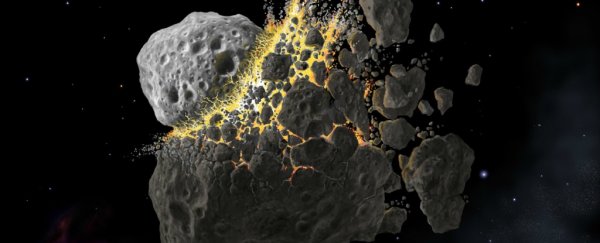Astronomers have found that the majority of meteorites that regularly fall into Earth's atmosphere today are the result of an asteroid collision that took place 466 million years ago.
Using chemical analysis from rock samples around the world, the team discovered that before that colossal collision, Earth experienced impacts from many different types of meteorite, meaning that our planet's history with meteorites is far more complex than we thought.
"Looking at the kinds of meteorites that have fallen to Earth in the last 100 million years doesn't give you a full picture," said team member Philipp Heck from the Field Museum in Chicago.
"It would be like looking outside on a snowy winter day and concluding that every day is snowy, even though it's not snowy in the summer."
Despite them all appearing the same when they streak through the night sky, meteorites actually come in a variety of different flavours depending on what parent body created them.
They form when rocky objects – such as asteroids, planets, or moons – collide, which breaks them apart into many different pieces.
These pieces fly out into space, and sometimes hit planets like Earth. The cool thing is that these meteorites all contain elements from the particular cosmic body that created them, giving researchers a unique, tangible glimpse into how celestial objects formed in our Solar System.
The problem is that astronomers really don't know that much about Earth's meteorite flux – the variety and amount of meteorites that have crashed into the planet over the course of its existence.
"We knew almost nothing about the meteorite flux to Earth in geological deep time before this study," explains team member Birger Schmitz from Lund University in Sweden.
"The conventional view is that the Solar System has been very stable over the past 500 million years. So it is quite surprising that the meteorite flux at 467 million years ago was so different from the present."
This means that Earth has seen the same type of meteorite rain down upon it for the last 466 million years.
These meteorites – called L chondrites – stem from a collision that took place between two cosmic bodies in the asteroid belt, though the event that created them isn't fully understood.
The problem is that the composition of these meteorites isn't representative of all of the different rocks in the asteroid belt, meaning that, at one point or another, Earth had different types of meteorites falling onto it.
To study what those meteorites were, Heck and his colleagues needed to find meteorites that landed on Earth's surface before the 'L chondrite parent body breakup' – the collision that's still raining rocks on us right now.
As you can probably imagine, finding 466 million-year-old rocks on a planet made of rock can be tough. So the team decided to analyse micrometeorites, which they excavated from a riverbed in Russia and dissolved in acid to see what types of crystals remained.
"It's a needle in the haystack problem," Heck told Sarah Kaplan at The Washington Post. "So we have to take a brute force approach: we burn away the haystack to find the needles."
The team was looking for chrome-spinels, which act like time capsules so the team can figure out where micrometeorites came from.
"Chrome-spinels, crystals that contain the mineral chromite, remain unchanged even after hundreds of millions of years," Heck explained.
"Since they were unaltered by time, we could use these spinels to see what the original parent body that produced the micrometeorites was made of."
After examining the chemical makeup of these chrome-spinels, the team found that 34 percent of the pre-collision micrometeorites were primitive achondrites, a type of meteorite that only makes up 0.45 percent of the ones that hit Earth today.
They also traced some of the samples back to Vesta, the brightest and one of the biggest asteroids in the asteroid belt, which they say also experienced its own collision over a billion years ago.
These findings suggest that just because we experience a significant flow of L chondrite meteorites today doesn't mean that it has always been this way. In fact, the history of Earth's meteorite flux is only now becoming known.
As team member William Bottke, from the Southwest Research Institute in Colorado, puts it:
"Meteorite delivery from the asteroid belt to the Earth is a little like observing landslides started at different times on a mountainside. Today, the rocks reaching the bottom of the mountain might be dominated by a few recent landslides.
Going back in time, however, older landslides should be much more important. The same is true for asteroid breakup events; some younger ones dominate the current meteorite flux, while in the past older ones dominated."
In other words, a better understanding of Earth's meteorite flux will give us a better understanding of the Solar System as a whole. But, as these findings show, to study them, researchers have to look back at the different time-frame.
"Knowing more about the different kinds of meteorites that have fallen over time gives us a better understanding of how the asteroid belt evolved and how different collisions happened," Heck concludes.
"Ultimately, we want to study more windows in time, not just the area before and after this collision during the Ordovician period, to deepen our knowledge of how different bodies in Solar System formed and interact with each other."
The team's work was published in Nature Astronomy.
